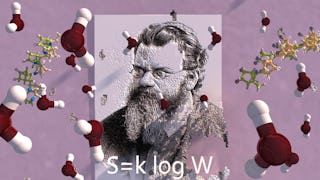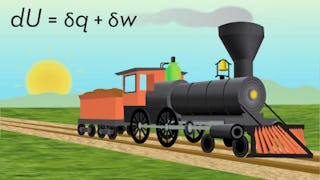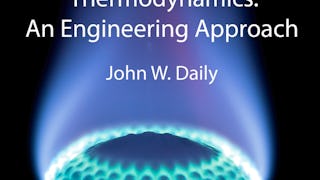Course 1 first explores the basics of both macroscopic and microscopic thermodynamics from a postulatory point of view. In this view, the meaning of temperature, thermodynamic pressure and chemical potential are especially clear and easy to understand. In addition , the development of the Fundamental Relation and its various transformations leads to a clear path to property relations and to the concept of ensembles needed to understand the relationship between atomic and molecular structural properties and macroscopic properties. We then explore the relationship between atomic and molecular structure and macroscopic properties by taking a statistical point of view. Using a postulatory approach, the method for doing this is made clear. This leads to the development of the partition function which describes the distribution of molecular quantum states as a function of the independent, macroscopic thermodynamic properties.



Fundamentals of Macroscopic and Microscopic Thermodynamics
This course is part of Statistical Thermodynamics Specialization

Instructor: John W. Daily
17,091 already enrolled
Included with 
(262 reviews)
What you'll learn
Explain the concept of temperature, thermodynamic pressure, and chemical potential from a postulatory perspective
Summarize the role of the Fundamental Relation in establishing connections between atomic/molecular structure and macroscopic properties
Skills you'll gain
Details to know

Add to your LinkedIn profile
6 assignments
See how employees at top companies are mastering in-demand skills

Build your subject-matter expertise
- Learn new concepts from industry experts
- Gain a foundational understanding of a subject or tool
- Develop job-relevant skills with hands-on projects
- Earn a shareable career certificate

There are 3 modules in this course
In this module we explore the basics of macroscopic thermodynamics from a postulatory point of view. In this view, the meaning of temperature, thermodynamic pressure and chemical potential are especially clear and easy to understand. In addition, the development of the Fundamental Relation and its various transformations leads to a clear path to property relations.
What's included
6 videos6 readings2 assignments1 peer review2 discussion prompts
We then explore the relationship between atomic and molecu-lar structure and macroscopic properties by taking a statistical point of view. Using apostulatory approach, the method for doing this is made clear. This leads to the devel-opment of the partition function which describes the distribution of molecular quantumstates as a function of the independent, macroscopic thermodynamic properties.
What's included
9 videos9 readings3 assignments5 discussion prompts
Here we explore microscopic thermodynamics from a postulatory point of view. We introduce the concept of ensembles as needed to understand the relationship between atomic and molecular structural properties and macroscopic properties. This leads to the partition function which relsates the distribution of molecular quantum states as a function of the independent, macroscopic thermodynamic properties.
What's included
6 videos6 readings1 assignment3 discussion prompts
Earn a career certificate
Add this credential to your LinkedIn profile, resume, or CV. Share it on social media and in your performance review.
Instructor

Offered by
Explore more from Mechanical Engineering


Carnegie Mellon University


University of Minnesota
 Status: Free Trial
Status: Free Trial
University of Colorado Boulder
 Status: Free Trial
Status: Free Trial
University of Colorado Boulder
Why people choose Coursera for their career




Learner reviews
262 reviews
- 5 stars
60.68%
- 4 stars
22.90%
- 3 stars
8.01%
- 2 stars
4.19%
- 1 star
4.19%
Showing 3 of 262
Reviewed on Jun 24, 2020
The fundamentals of the micro and macro thermodynamics world is now known by me.
Reviewed on Jul 23, 2022
Sublime Course with very good presentations , obviously requires basic understanding to go through the course , must do for a mechanical student if aiming for higher studies
Reviewed on Aug 19, 2020
I am really satisfied by doing this online course,

Open new doors with Coursera Plus
Unlimited access to 10,000+ world-class courses, hands-on projects, and job-ready certificate programs - all included in your subscription
Advance your career with an online degree
Earn a degree from world-class universities - 100% online
Join over 3,400 global companies that choose Coursera for Business
Upskill your employees to excel in the digital economy
Frequently asked questions
Access to lectures and assignments depends on your type of enrollment. If you take a course in audit mode, you will be able to see most course materials for free. To access graded assignments and to earn a Certificate, you will need to purchase the Certificate experience, during or after your audit. If you don't see the audit option:
The course may not offer an audit option. You can try a Free Trial instead, or apply for Financial Aid.
The course may offer 'Full Course, No Certificate' instead. This option lets you see all course materials, submit required assessments, and get a final grade. This also means that you will not be able to purchase a Certificate experience.
When you enroll in the course, you get access to all of the courses in the Specialization, and you earn a certificate when you complete the work. Your electronic Certificate will be added to your Accomplishments page - from there, you can print your Certificate or add it to your LinkedIn profile. If you only want to read and view the course content, you can audit the course for free.
If you subscribed, you get a 7-day free trial during which you can cancel at no penalty. After that, we don’t give refunds, but you can cancel your subscription at any time. See our full refund policy.
More questions
Financial aid available,

